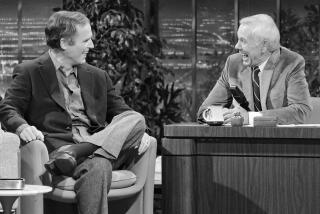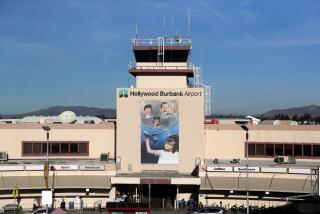SECOND OPINIONS : Real Airport Economics Entail Wide Perspective : An editorial criticizing authority expenses just camouflages the basic issue--a new Burbank terminal. It’s time everyone quit fighting and get to the point.
- Share via
The Times news coverage and subsequent editorial (Nov. 12, 14) on Burbank Airport staff expenses commit the often repeated sin of the news media--namely slanting a story one way, getting some of it right but not all of it right, and then editorializing on a supposed truth that the newspaper has itself erroneously created. The Times says the airport is choking on “credibility sandwiches.” Readers should not forget that The Times is serving as executive chef!
The device is simple: Pull a few titillating expense items--accurately itemized by the airport--out of the whole record, and by implication paint the entire body of expenses with the same brush.
The Times holds out John Wayne Airport and Sacramento Metro Airport as comparable airports where less money is spent on travel and training. Fine. That doesn’t mean those airports are right and Burbank Airport is wrong.
The Times didn’t even look at the possible contrast in priorities between the three airports, which might explain some or all of the differences, and neither did The Times make an attempt to discover whether county-owned airports such as John Wayne and Sacramento might inherently have differences because of accounting practices, government structure or just plain politics when compared to a stand-alone airport authority.
So what has The Times not told its readers?
Most important, it did not tell readers that the airlines--not taxpayers--are the parties who are on the hook for airport expenses and have the most to lose if the airport spends too much in any category. Yet all of the airlines serving Burbank Airport fully endorse the Airport Authority’s management of the facility, and that includes the meeting and training expenses pummeled by The Times. Names and telephone numbers of principal airline representatives were supplied to The Times; no airline point of view was in the story.
The Times gave some ink to a Burbank city councilman’s assertion that the expenses in question are paid with taxpayer money. They never offered that assertion for airport comment. The fact is that not one dime of these expenses is paid by any form of taxpayer funds. Period.
Totally missing from The Times editorial is any attempt at evaluating whether there has been a worthwhile return on investment for the expenditures. The fact of the matter is this airport--through its persistent communications with Washington--has lined up more than $38 million in discretionary federal grants that would not otherwise have been forthcoming; its request for an additional $34 million in passenger facility charges passed both FAA and airline scrutiny with flying colors; and it had previously arranged a $100-million credit line with Wall Street by going to New York and ensuring that investors had a firm understanding of solid management practices at the airport.
Instead of taking potshots at the authority, The Times should be commending it for making sure the dollars are in place to ensure the viability of this facility for the next century. It should also commend the authority for making sure that staff and commissioners alike are well-grounded in the aviation policy issues underlying the national air transportation arena in which the airport operates.
The Times was right on a couple of points, however. Critics of the airport’s case for building a new terminal are using every extraneous detail they can squeeze out of attention to travel and training expenses to divert attention from the truly significant debate over the terminal.
The Airport Authority agrees that mature dialogue is needed between Burbank Airport and its neighbors. The authority has consistently pursued that goal and will continue to do so. The fact that some choose to wave expenses recklessly as an excuse to claim “erosion of public trust” should be shown for what it is: a tactic for disruption, pure and simple.
More to Read
Inside the business of entertainment
The Wide Shot brings you news, analysis and insights on everything from streaming wars to production — and what it all means for the future.
You may occasionally receive promotional content from the Los Angeles Times.










